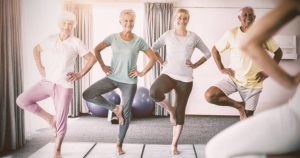
Want to get the most out of your regular physical activity? Try these recommendations, based on national guidelines, medical research and Mayo Clinic expertise. After all, a well-rounded fitness program may be one of the best things you can do for your health.
Make it functional. Functional fitness exercises train your muscles to help you do everyday activities safely and efficiently. These exercises train your muscles to work together and prepare them for daily tasks by simulating common movements you might do at home, at work or in sports. By doing functional exercises, you gain awareness of how your body coordinates and supports movement. Being more aware of your body’s movement patterns helps facilitate balance, strength, flexibility and endurance. This type of training can be done at home or at the gym. Exercise tools, such as fitness balls, kettle bells and weights, can be used as part of your training.
Count cardio in. Aerobic activity, or cardio, gets your heart pumping and helps move blood to your muscles and back to your lungs. This helps you use oxygen more efficiently. Walking, bicycling, swimming, dancing and water aerobics are all examples of cardio activities. Including a variety of them will help keep you from getting bored and can help you live a longer, healthier life.
Focus on flexibility. Stretching increases your flexibility, improves range of motion of your joints and helps your blood circulate well. It can even help you improve your posture and manage stress. Although many people think of stretching exercises as an afterthought or as a quick chore on the way to the “real” workout, stretching is a powerful part of any exercise plan. You can stretch anytime, anywhere — in your home, at work or when you’re traveling.
Strengthen your muscles. Regular strength-training exercises can help you preserve and enhance muscle mass at any age. Strength training also helps you strengthen your bones, gain less body fat and protect your joints, which can help lower your chances of injuring yourself. Strength training can be done at home or in the gym, using just your body or a variety of equipment. With the right technique, you may see improvements in your strength and stamina in just a few weeks.
Find balance. Often overlooked as part of physical fitness, balance exercises are helpful at any age. As you age, balance becomes more and more important to maintaining your independence. Nearly any activity that keeps you on your feet and moving can help you maintain good balance.
These key principles create a well-rounded fitness program that can boost not only your fitness, but also your health and quality of life!












